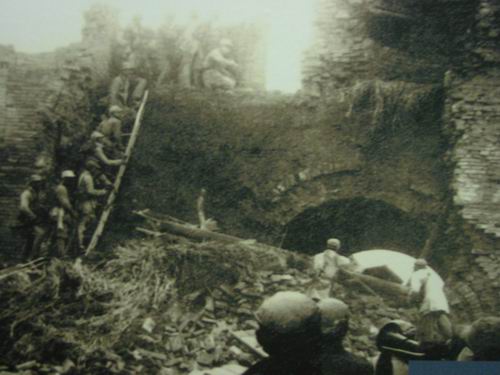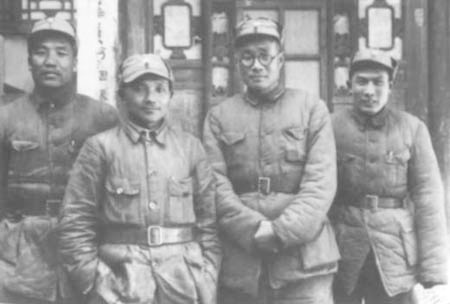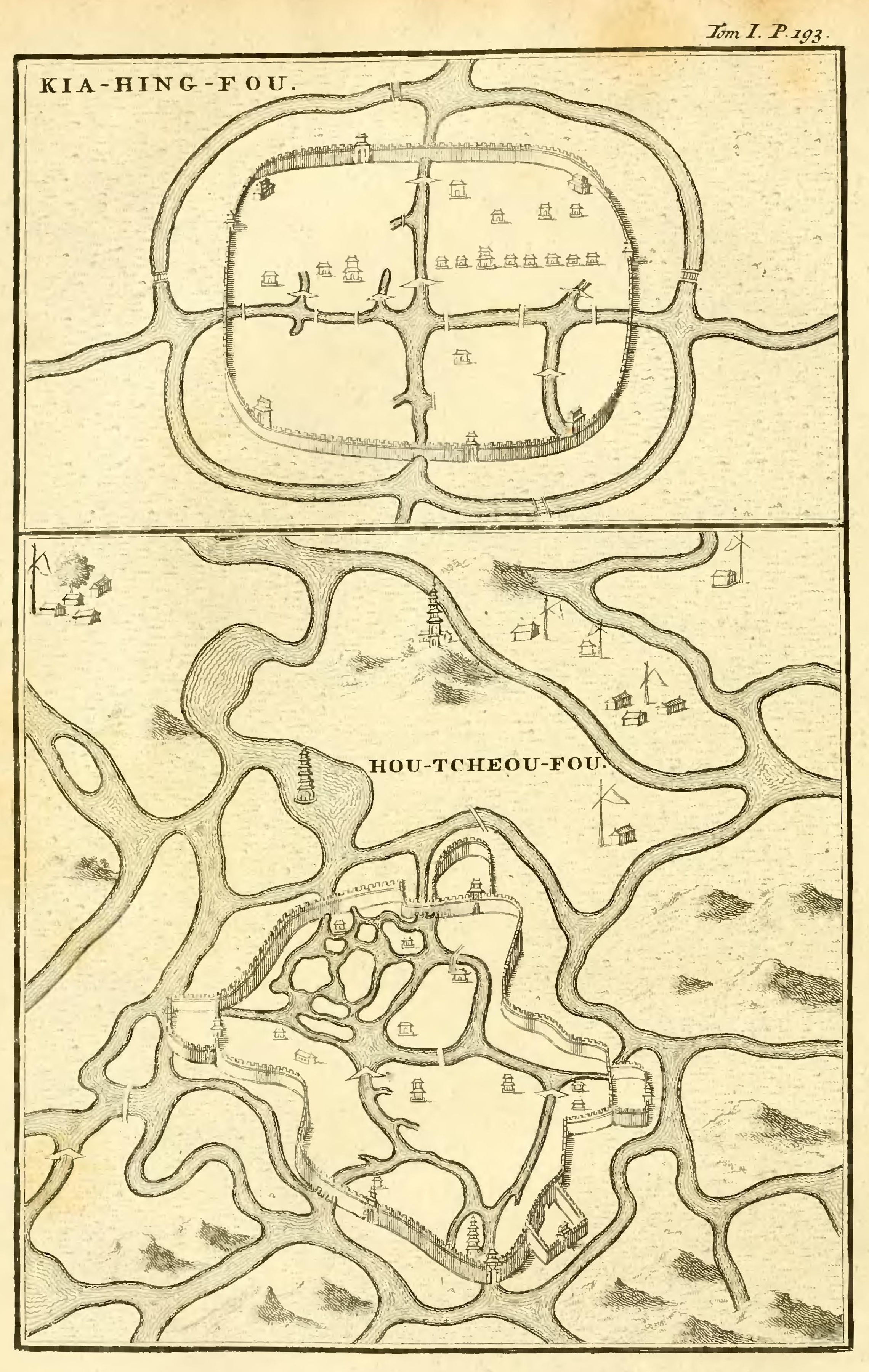|
Shanghai Campaign
The Shanghai Campaign was a series of battles fought between the nationalists and the Chinese Communist Party (CCP) in 1949 for the control of Shanghai, the largest city in China in the latter stage of the Chinese Civil War, and resulted in the city being taken over by the communists, who enjoyed numerical superiority. Prelude With a population of six million, Shanghai was the largest city in China in 1949 and provided around a third of the total GDP of China by that time. Defending force: the nationalist strategy The nationalist commander divided the city into two sectors along the Huangpu River. The western half of the city and the surrounding regions including Taicang, Kunshan, Jiaxing, and Golden Mountain Jinshan, were defended by a total of 20 divisions (including all of the armored force) belonging to the 21st Army, the 51st Army, the 52nd Army, the 54th Army, the 75th Army and the 123rd Army. The 12th Army and the 35th Army totaled five divisions and the naval ... [...More Info...] [...Related Items...] OR: [Wikipedia] [Google] [Baidu] |
Chinese Civil War
The Chinese Civil War was fought between the Kuomintang-led Nationalist government, government of the Republic of China (1912–1949), Republic of China and the forces of the Chinese Communist Party (CCP). Armed conflict continued intermittently from 1 August 1927 until Communist victory resulted in their total control over mainland China on 7 December 1949. The war is generally divided into two phases with an interlude: from August 1927 to 1937, the First United Front alliance of the KMT and CCP collapsed during the Northern Expedition, and the Nationalists controlled most of China. From 1937 to 1945, hostilities were mostly put on hold as the Second United Front fought the Second Sino-Japanese War, Japanese invasion of China with eventual help from the Allies of World War II. However, armed clashes between the groups remained common. Exacerbating the divisions within China further was the formation of the Wang Jingwei regime, a Japan-sponsored puppet government led by Wang ... [...More Info...] [...Related Items...] OR: [Wikipedia] [Google] [Baidu] |
People's Liberation Army
The People's Liberation Army (PLA) is the military of the Chinese Communist Party (CCP) and the People's Republic of China (PRC). It consists of four Military branch, services—People's Liberation Army Ground Force, Ground Force, People's Liberation Army Navy, Navy, People's Liberation Army Air Force, Air Force, and People's Liberation Army Rocket Force, Rocket Force—and four arms—People's Liberation Army Aerospace Force, Aerospace Force, People's Liberation Army Cyberspace Force, Cyberspace Force, People's Liberation Army Information Support Force, Information Support Force, and People's Liberation Army Joint Logistics Support Force, Joint Logistics Support Force. It is led by the Central Military Commission (China), Central Military Commission (CMC) with its Chairman of the Central Military Commission (China), chairman as Supreme Military Command of the People's Republic of China, commander-in-chief. The PLA can trace its origins during the Republic of China (1912– ... [...More Info...] [...Related Items...] OR: [Wikipedia] [Google] [Baidu] |
Jinhua
Jinhua is a prefecture-level city in central Zhejiang province in eastern China. It borders the provincial capital of Hangzhou to the northwest, Quzhou to the southwest, Lishui to the south, Taizhou, Zhejiang, Taizhou to the east, and Shaoxing to the northeast. Its population was 7,050,683 as of the 2020 census including 1,463,990 in the built-up (or metro) area made of two urban districts (not including yet the satellite city of Lanxi, Zhejiang, Lanxi, which has become essentially a suburban offshoot of Jinhua's main urban area). Jinhua is rich in Ultisols, red soil and forest resources. The Jinhua or Wu River flows through the Lan and Fuchun to the Qiantang River beside Hangzhou, which flows into Hangzhou Bay and the East China Sea. In medieval China, it formed part of the water network feeding supplies to the southern end of the Grand Canal of China, Grand Canal. It is best known for its dry-cured Jinhua ham. History and culture The history of Jinhua dates back to the 2nd ... [...More Info...] [...Related Items...] OR: [Wikipedia] [Google] [Baidu] |
Deng Xiaoping
Deng Xiaoping also Romanization of Chinese, romanised as Teng Hsiao-p'ing; born Xiansheng (). (22 August 190419 February 1997) was a Chinese statesman, revolutionary, and political theorist who served as the paramount leader of the People's Republic of China from 1978 to 1989. In the aftermath of Mao Zedong's Death and state funeral of Mao Zedong, death in 1976, Deng succeeded in consolidating power to lead China through a period of reform and opening up that transformed its economy into a socialist market economy. He is widely regarded as the "Architect of Modern China" for his contributions to socialism with Chinese characteristics and Deng Xiaoping Theory. Born in Sichuan, the son of landowning peasants, Deng first learned of Marxism–Leninism while studying and working abroad in France in the early 1920s through the Work-Study Movement. In France, he met future collaborators like Zhou Enlai. In 1924, he joined the Chinese Communist Party (CCP) and continued his studies in ... [...More Info...] [...Related Items...] OR: [Wikipedia] [Google] [Baidu] |
Liu Bocheng
Liu Mingzhao (; 4 December 1892 – 7 October 1986), more commonly known as Liu Bocheng (), was a Chinese military officer and Marshal of the People's Republic of China. Known as the 'half' of the "Three and A Half" Strategists of China in modern Chinese history, he was recognised as a revolutionary, military strategist, and theoretician and one of the founders of the People's Liberation Army (PLA). Liu's nicknames "''The Kutuzov of China"'' and ''The "One-eyed Dragon"'', were a reflection of his character, military achievement, Soviet military education and the fact that he lost his right eye in battle. Early life Liu was born to a peasant family in Kaixian, Sichuan (the site is currently submerged by the Three Gorges Dam). Influenced by the revolutionary theories of Sun Yat-sen, he later decided to dedicate himself to the cause of establishing a democratic and modern China. In 1911, Liu joined the Boy Scouts in support of the Xinhai Revolution. In the following year, he e ... [...More Info...] [...Related Items...] OR: [Wikipedia] [Google] [Baidu] |
Gaoqiao, Shanghai
Gaoqiao () is a town in Pudong New Area in Shanghai, China. Gaoqiao Old Town dates back to the Southern Song dynasty. Gaoqiao New Town, also known as Holland Village or Holland Town, is a new town with a Dutch architectural theme. Gaoqiao is located at the northern end of Pudong, on the east bank of the Huangpu River and next to Waigaoqiao Free Trade Zone. It has an area of 39 square kilometres, and had a registered population of 84,900 in 2008. The town is served by Shanghai Metro Line 6. Gaoqiao New Town arose from the One City, Nine Towns policy, which was initiated in 2001. Each of the suburban districts of Shanghai was assigned a new town, each with its own theme. Pudong's new town was assigned to Gaoqiao, with a Dutch theme. Other Western themes used to date are Scandinavian, Italian, Spanish, Canadian, English and German. Dutch architectural firms Kuiper Compagnons and Atelier Dutch jointly produced the design for the town's initial development, covering an area of 1 s ... [...More Info...] [...Related Items...] OR: [Wikipedia] [Google] [Baidu] |
Wusong
Wusong, Postal romanization, formerly romanized as Woosung, is a subdistrict of Baoshan District, Shanghai, Baoshan in northern Shanghai. Prior to the city's expansion, it was a separate port town located down the Huangpu River from Shanghai's urban core. Name Wusong is named for the Wusong River, a former name for Shanghai's Suzhou Creek. Suzhou Creek is now a tributary to the Huangpu River, emptying into it in Puxi across from Lujiazui and just north of the The Bund, Bund. The Huangpu had previously been a tributary to the Wusong, but the two reversed their importance when a flood caused it to gain a number of the Wusong's former tributaries. The location where the Huangpu and Wusong meet was generally known as ''Wusongkou'' ("mouth of the Wusong"). As a result of an American railroader visiting the area in his sea captain days, it would also become the namesake for an unincorporated community in southwestern Ogle County, Illinois, northwest of Dixon. History Wusong housed ... [...More Info...] [...Related Items...] OR: [Wikipedia] [Google] [Baidu] |
Pudong
Pudong is a list of administrative divisions of Shanghai, district of Shanghai located east of the Huangpu River, Huangpu, the river which flows through central Shanghai. The name ''Pudong'' was originally applied to the Huangpu's east bank (geography), bank, directly across from the west bank or Puxi, the historic city center. It now refers to the broader Pudong New Area, a new areas, state-level new area which extends all the way to the East China Sea. The traditional area of Pudong is now home to the Lujiazui, Lujiazui Finance and Trade Zone and the Shanghai Stock Exchange and many of Shanghai's best-known buildings, such as the Oriental Pearl Tower, the Jin Mao Tower, the Shanghai World Financial Center, and the Shanghai Tower. These modern skyscrapers directly face Puxi's historic The Bund (Shanghai), Bund, a remnant of former concessions in China, foreign concessions in China. The rest of the new area includes the Port of Shanghai, the Shanghai Expo Park, Shanghai Expo a ... [...More Info...] [...Related Items...] OR: [Wikipedia] [Google] [Baidu] |
Jinshan District
Jinshan District, is a suburban district of southwestern Shanghai, neighboring Zhejiang province and Hangzhou Bay. It has a land area of and a population of 732,500 as of the 2010 Chinese census. Jinshan District, located in the southwest of Shanghai, is one of the biggest districts of the city. Local political administration is divided into nine towns and one subdistrict. About off the coast of Jinshan, there are three islands named Dajinshan ("Big Gold Mountain"), Xiaojinshan ("Little Gold Mountain"), and Fushan ("Floating Mountain"). At above sea level, the peak of Dajinshan Island is the highest point within the Shanghai municipality. There are several beaches along the shoreline, which are popular tourism destinations. As the city of Shanghai has grown, Jinshan has experienced rapid changes, evolving from a relatively rural area to a more suburban environment. With completion of the high-speed highway in 2008, a new bus line was opened between Shanghai and Jinsha ... [...More Info...] [...Related Items...] OR: [Wikipedia] [Google] [Baidu] |
Jiaxing
Jiaxing (), alternately romanized as Kashing, is a prefecture-level city in northern Zhejiang province, China. Lying on the Grand Canal of China, Jiaxing borders Hangzhou to the southwest, Huzhou to the west, Shanghai to the northeast, and the province of Jiangsu to the north. As of the 2020 census, its population was 5,400,868 and its built-up (or metro) area made of 2 urban districts was home to 1,518,654 inhabitants. Administration Jiaxing is the birthplace of the Majiabang Culture in the Neolithic Age. The ancestors engaged in farming, animal husbandry, fishing and hunting 7,000 years ago. The prefecture-level city of Jiaxing administers 7 Administrative divisions of the People's Republic of China#County level, county-level divisions, including 2 District of China, districts, 3 county-level city, county-level cities and 2 County (People's Republic of China), counties. These are further divided into 75 Administrative divisions of the People's Republic of China#Township lev ... [...More Info...] [...Related Items...] OR: [Wikipedia] [Google] [Baidu] |
Kunshan
Kunshan is a county-level city in southeastern Jiangsu Province, Jiangsu province with Shanghai bordering its eastern border and Suzhou on its western boundary. It is under the administration of the prefecture-level city of Suzhou. Name There is a strong possibility that the name Kunshan is derived from a hill, but which one is controversial. According to an impacted version, the hill is present-day Little Kunshan (''Xiaokunshan'') in Shanghai's Songjiang District. The character (''Kun'') was the old Chinese name for the Kunlun Mountains. From it developed the chengyu, Chinese idiom "a jade from Kunlun Mountains", meaning any "outstanding figure". This was applied to Lu Ji (Shiheng), Lu Ji and a hill in his hometown was designated as Kun to commemorate him. History Lou county () which administered Kunshan and the area around was established in Qin dynasty. It was named after Lou River (; present-day Liu River: ), while its seat was located in the north eastern of Kunsha ... [...More Info...] [...Related Items...] OR: [Wikipedia] [Google] [Baidu] |








